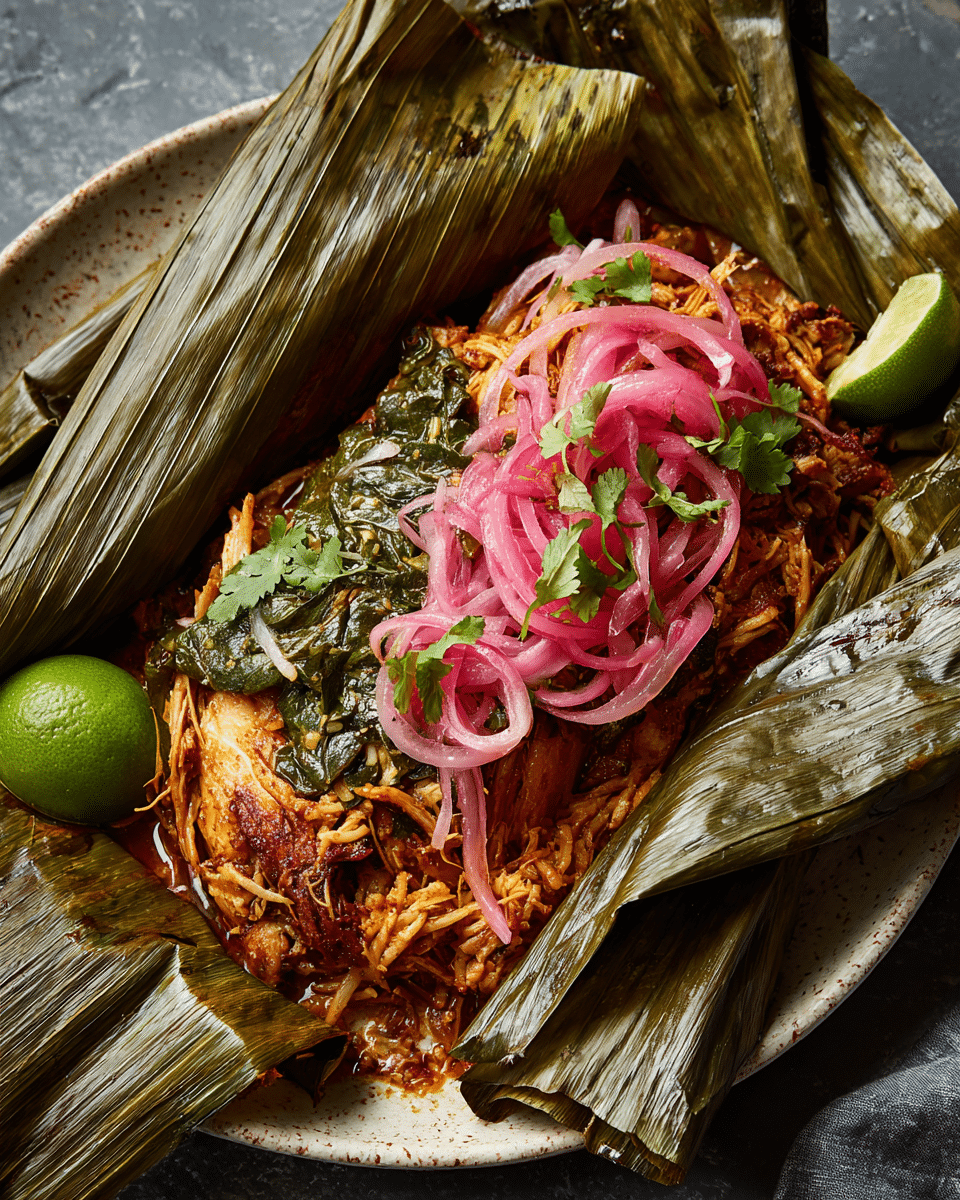Cochinita Pibil is a traditional Mexican dish from the Yucatán Peninsula, famous for its vibrant flavors and tender, juicy pork. The name comes from “cochinita” (little pig) and “pibil,” meaning “buried,” a reference to the ancient method of slow-cooking meat underground wrapped in banana leaves. This recipe captures the essence of the original, using citrus juices, earthy annatto paste, and fragrant spices to create a rich, tangy, and slightly smoky taste. Perfect for celebrating
FULL RECIPE
Ingredients
- 3 lbs (1.36 kg) pork shoulder or pork butt, cut into large chunks
- 1/2 cup (120 ml) fresh orange juice
- 1/4 cup (60 ml) fresh lime juice
- 1/4 cup (60 ml) white vinegar
- 1/2 cup (120 g) achiote paste (annatto paste)
- 4 cloves garlic, minced
- 1 tbsp ground cumin
- 1 tbsp dried oregano
- 1 tsp ground cinnamon
- 1 tsp smoked paprika
- 1 tbsp salt
- 1 tsp black pepper
- 1/4 cup (60 ml) olive oil
- 2 banana leaves (optional, for wrapping)
- 1/2 cup (120 ml) chicken broth
- Pickled red onions, for serving
- Warm corn tortillas, for serving
Directions
- In a large mixing bowl, combine orange juice, lime juice, vinegar, achiote paste, garlic, cumin, oregano, cinnamon, smoked paprika, salt, black pepper, and olive oil. Whisk until the paste is fully dissolved and the marinade is smooth.
- Add the pork chunks to the bowl and coat them thoroughly with the marinade. Cover and refrigerate for at least 4 hours, preferably overnight for maximum flavor.
- Preheat the oven to 325°F (165°C).
- If using banana leaves, briefly pass them over an open flame or hot pan to soften and make them pliable. Line a roasting pan with the banana leaves, leaving enough overhang to wrap over the pork.
- Place the marinated pork in the prepared pan, pour in chicken broth, and fold the banana leaves over the meat. If not using banana leaves, cover the pork tightly with aluminum foil.
- Roast in the preheated oven for 3.5 to 4 hours, or until the pork is fork-tender and easily shreds.
- Remove from the oven, shred the pork using two forks, and mix it back into the juices for extra flavor.
- Serve hot with pickled red onions and warm corn tortillas.
Nutrition Facts
- Calories: 420
- Protein: 32g
- Total Fat: 28g
- Saturated Fat: 9g
- Cholesterol: 105mg
- Carbohydrates: 6g
- Fiber: 2g
- Sugars: 2g
- Sodium: 870mg
- Potassium: 630mg
Origins of Cochinita Pibil
Cochinita Pibil traces its roots to the Yucatán Peninsula, where it was traditionally made using whole suckling pig marinated in achiote paste and citrus juice, then wrapped in banana leaves and slow-cooked in a pit oven called a “pib.” This ancient Mayan cooking method infused the meat with smoky, earthy flavors while keeping it incredibly tender. Over time, the recipe evolved to accommodate modern kitchens, using ovens or slow cookers while maintaining the same characteristic taste. Its cultural significance is strong, as it is often prepared for festivals, family gatherings, and celebrations, making it a treasured part of Mexican culinary heritage.
Flavor Profile and Aroma
The hallmark of Cochinita Pibil’s flavor is the combination of tangy citrus, earthy annatto, and warm spices. The achiote paste imparts a subtle peppery note and a distinctive deep red-orange color. The orange and lime juices provide brightness, balancing the richness of the pork, while cumin, oregano, and cinnamon lend a complex aromatic depth. Slow cooking allows these flavors to meld together, producing a melt-in-your-mouth texture that releases bursts of smokiness and spice in every bite.
Nutritional Value
While Cochinita Pibil is rich and flavorful, it also offers nutritional benefits when enjoyed in moderation. Pork shoulder is a good source of high-quality protein, essential for muscle repair and energy. The citrus marinade provides a dose of vitamin C, while spices like cumin and oregano contain antioxidants that support overall wellness. However, because pork shoulder is naturally higher in fat, portion control can help balance calorie intake. Pairing it with fresh vegetables or serving it in small tortilla portions can make it part of a balanced meal.
Traditional Cooking Method
In its most authentic form, Cochinita Pibil is prepared in a subterranean oven. The meat is wrapped in banana leaves to trap moisture and flavor, then placed in a pit lined with hot stones and covered with earth to create an even, low heat. This method can take many hours but results in a uniquely smoky and tender dish. While most home cooks today use ovens, Dutch ovens, or slow cookers, the principle of low and slow cooking remains essential for achieving the traditional taste and texture.
Modern Variations
Though pork is the classic choice, modern interpretations of Cochinita Pibil often adapt the recipe to accommodate different dietary needs. Chicken, turkey, or even jackfruit can be used as substitutes for those seeking lighter or plant-based options. Some cooks experiment by adding chili peppers for extra heat or substituting grapefruit juice for a sharper citrus profile. The flexibility of the marinade makes it easy to personalize while still honoring the dish’s traditional essence.
Serving Suggestions
Cochinita Pibil is often served shredded and accompanied by pickled red onions, which provide a tangy contrast to the richness of the meat. Warm corn tortillas are the traditional pairing, allowing diners to assemble tacos or wraps. For a more elaborate spread, the dish can be served alongside black beans, rice, and fresh salsas. Garnishes such as chopped cilantro, avocado slices, and lime wedges enhance both the flavor and presentation, making it ideal for festive gatherings.
Perfect Pairings
The bright and savory flavors of Cochinita Pibil pair beautifully with a variety of side dishes and drinks. Refreshing beverages like horchata, hibiscus tea, or citrus-infused sparkling water complement the tangy marinade. On the side, consider roasted plantains, grilled corn, or a fresh jicama salad to balance the richness of the pork. For a special celebration, pairing the dish with a crisp lager or light-bodied red wine can elevate the dining experience.
Storage and Reheating Tips
Leftover Cochinita Pibil stores well in the refrigerator for up to four days when kept in an airtight container. It can also be frozen for up to three months without significant loss of flavor or texture. To reheat, it’s best to warm the meat gently over low heat in a skillet with a splash of broth or its own juices to prevent it from drying out. This makes it an excellent make-ahead dish for parties or busy weeknight meals.
Cultural Significance in Celebrations
Cochinita Pibil is a dish often associated with festive occasions in Mexico, particularly in the Yucatán region. It is commonly featured during Día de los Muertos, weddings, and national celebrations such as Mexican Independence Day. Serving Cochinita Pibil at such events not only delights guests but also connects them to centuries-old traditions, reinforcing a sense of cultural identity and pride. Its communal preparation and serving style make it a centerpiece for shared meals.
Health-Conscious Adaptations
For those seeking a lighter version, Cochinita Pibil can be adapted without losing its iconic flavor. Leaner cuts of pork, like tenderloin, can replace pork shoulder, and reduced amounts of oil in the marinade can lower the fat content. Serving the dish in lettuce wraps instead of tortillas is another way to reduce carbohydrates while keeping the fresh, vibrant flavors intact. These adjustments make it possible to enjoy this traditional dish while meeting personal dietary goals.
Conclusion
Cochinita Pibil is more than just a flavorful pork dish—it is a symbol of Yucatán’s rich culinary history and the artistry of slow cooking. From its aromatic spice blend to its tender, citrus-infused meat, it offers a sensory experience that bridges past and present. Whether prepared traditionally in banana leaves or adapted for modern kitchens, it remains a dish that invites sharing and celebration.






